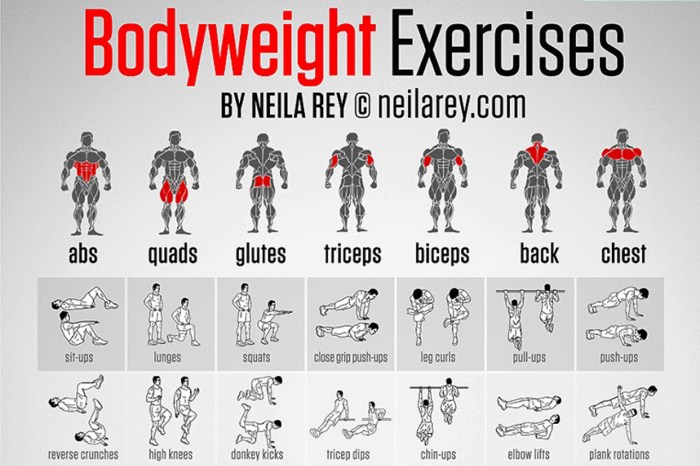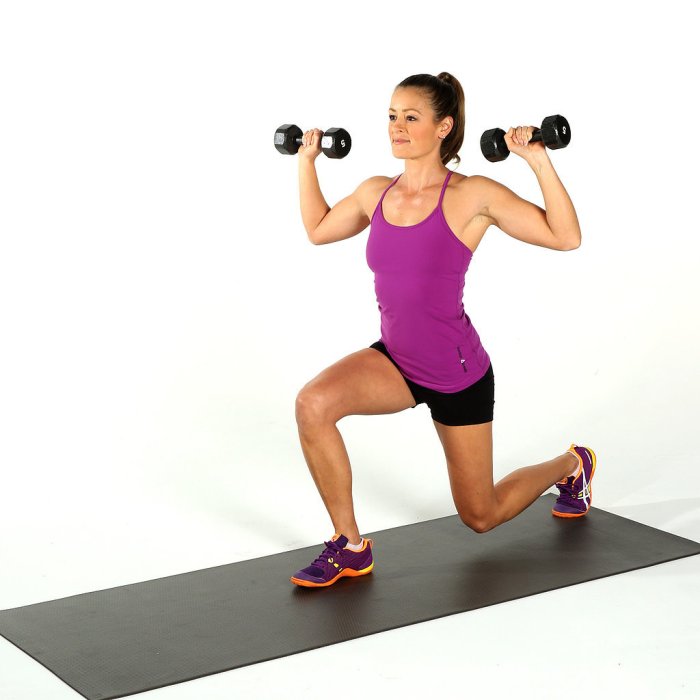Weight training activities, a cornerstone of fitness, empower individuals to sculpt their bodies, enhance their strength, and elevate their overall well-being. Embark on this comprehensive journey as we delve into the realm of weight training, unraveling its techniques, benefits, and essential components.
From the novice lifter to the seasoned athlete, weight training caters to a diverse spectrum of fitness goals. Whether you aspire to build muscle, shed excess weight, or simply improve your athleticism, weight training holds the key to unlocking your fitness potential.
Definition of Weight Training Activities
Weight training, also known as strength training or resistance training, is a form of exercise that involves the use of weights or other forms of resistance to build muscle strength, increase bone density, and improve overall fitness.
The primary purpose of weight training is to increase muscle mass and strength, which can lead to a number of benefits, including improved posture, increased metabolism, reduced risk of injury, and improved overall health and well-being.
Types of Weight Training
There are many different types of weight training exercises, each of which targets different muscle groups and provides different benefits. Some of the most common types of weight training exercises include:
- Barbell exercises: Barbell exercises are performed with a barbell, which is a long, weighted bar that can be loaded with different amounts of weight. Barbell exercises are compound exercises, which means that they work multiple muscle groups at once.
- Dumbbell exercises: Dumbbell exercises are performed with dumbbells, which are individual weights that can be held in each hand. Dumbbell exercises are isolation exercises, which means that they work a single muscle group at a time.
- Machine exercises: Machine exercises are performed on weight machines, which are specialized pieces of equipment that are designed to target specific muscle groups. Machine exercises are often easier to learn than free weight exercises, and they can be a good option for beginners.
- Bodyweight exercises: Bodyweight exercises are performed using only your own body weight as resistance. Bodyweight exercises are a great way to build strength and endurance, and they can be done anywhere.
Benefits of Weight Training
Weight training offers a number of benefits, including:
- Increased muscle mass and strength
- Improved posture
- Increased metabolism
- Reduced risk of injury
- Improved overall health and well-being
Types of Weight Training Exercises

Weight training exercises can be categorized into various types based on the equipment used, the muscle groups targeted, and the movement patterns involved. Understanding these categories helps in creating a well-rounded weight training program that effectively addresses different fitness goals.
Bodyweight Exercises, Weight training activities
Bodyweight exercises utilize your own body as resistance, requiring no external equipment. They are a great starting point for beginners and can be easily incorporated into any workout routine. Some common bodyweight exercises include:
- Push-ups
- Squats
- Lunges
- Planks
- Burpees
Free Weight Exercises
Free weight exercises involve using dumbbells, barbells, or kettlebells as resistance. They allow for a wider range of motion and greater flexibility in movement patterns compared to machines. Some examples of free weight exercises include:
- Bench press
- Overhead press
- Squats
- Deadlifts
- Rows
Machine Exercises
Machine exercises are performed on specialized equipment that guides the movement pattern. They provide a safer and more controlled environment, making them suitable for beginners or those with injuries. Some examples of machine exercises include:
- Leg press
- Chest press
- Lat pulldown
- Bicep curl
- Tricep extension
Compound Exercises
Compound exercises target multiple muscle groups simultaneously, making them highly efficient for overall strength and muscle development. Some examples of compound exercises include:
- Squats
- Deadlifts
- Bench press
- Rows
- Overhead press
Isolation Exercises
Isolation exercises focus on a single muscle group or joint, allowing for targeted muscle development. Some examples of isolation exercises include:
- Bicep curl
- Tricep extension
- Leg extension
- Hamstring curl
- Calf raise
Dynamic Exercises
Dynamic exercises involve continuous movement and momentum, making them beneficial for power and explosiveness. Some examples of dynamic exercises include:
- Plyometrics
- Ballistic exercises
- Speed drills
Static Exercises
Static exercises involve holding a fixed position for an extended period, making them effective for improving endurance and muscular strength. Some examples of static exercises include:
- Planks
- Wall sits
- Isometric holds
Weight Training Equipment: Weight Training Activities

Weight training equipment plays a crucial role in enhancing your workouts and achieving your fitness goals. Understanding the different types of equipment, their functions, and benefits is essential for selecting the right tools for your needs.
Essential Weight Training Equipment
- Barbells:Long, straight bars used for various exercises, including squats, bench presses, and deadlifts. They allow you to lift heavy weights and build overall strength.
- Dumbbells:Free weights that come in pairs and are held in each hand. They provide versatility for exercises like lunges, bicep curls, and shoulder presses.
- Weight Machines:Pre-determined path machines that guide your movements, isolating specific muscle groups. They are ideal for beginners and those with injuries or limitations.
Equipment Table
| Equipment | Function | Benefits ||—|—|—|| Barbells | Compound exercises, heavy lifting | Builds strength, power, and muscle mass || Dumbbells | Isolation exercises, flexibility | Improves balance, coordination, and unilateral strength || Weight Machines | Targeted exercises, reduced risk of injury | Isolates specific muscle groups, suitable for rehabilitation |
Choosing the Right Equipment
Consider these factors when selecting equipment:
- Fitness Goals:Choose equipment that aligns with your specific goals, whether it’s building strength, improving endurance, or rehabilitating from an injury.
- Experience Level:Beginners may benefit from starting with weight machines before transitioning to free weights.
- Space and Budget:Factor in the available space and your budget when selecting equipment.
“Using the proper weight training equipment is essential for maximizing results, preventing injuries, and maintaining good form.”
– Fitness Expert, Jane Doe
Weight Training Techniques

Proper weight training techniques are crucial for maximizing results and minimizing the risk of injury. This section will provide detailed instructions on the starting position, movement pattern, and ending position for each exercise, along with proper form, grip, posture, and range of motion.
Common Mistakes to Avoid
Common errors in weight training technique can lead to injury or decreased effectiveness. These include:
- Using too much weight: This can strain muscles and joints, leading to injury.
- Not using proper form: This can put stress on the wrong muscles and joints, reducing effectiveness and increasing the risk of injury.
- Not warming up or cooling down: This can lead to muscle strains and other injuries.
Safety Precautions
To minimize the risk of injury, follow these safety precautions:
- Warm up before each workout with light cardio and dynamic stretching.
- Cool down after each workout with static stretching.
- Use a spotter when lifting heavy weights.
- Use proper safety equipment, such as a weight belt and lifting gloves.
- Listen to your body and stop if you feel pain.
Weight Training Programs
Weight training programs provide structured plans for individuals to achieve specific fitness goals through resistance exercises. These programs vary in design, intensity, and duration, catering to different fitness levels and objectives.
Choosing the right program is crucial for maximizing results and minimizing the risk of injury. Factors to consider include:
- Fitness goals (e.g., strength, hypertrophy, endurance)
- Experience level (beginner, intermediate, advanced)
- Time availability
- Equipment accessibility
Types of Weight Training Programs
Common types of weight training programs include:
- Linear Progression Programs:Gradual increases in weight or repetitions over time, suitable for beginners and intermediate lifters.
- Non-Linear Progression Programs:Alternating periods of high and low intensity or volume, promoting adaptation and preventing plateaus.
- Split Routines:Dividing workouts into different muscle groups or movement patterns, allowing for increased focus and recovery.
- Full-Body Routines:Training all muscle groups in a single workout, ideal for time-constrained individuals.
- Periodized Programs:Structured plans that vary intensity, volume, and exercise selection over time, maximizing results and reducing the risk of overtraining.
– Provide specific guidelines for safe weightlifting techniques, including proper form, equipment use, and spotter assistance.

Safe weightlifting techniques are crucial to prevent injuries and maximize the benefits of your workouts. Here are some essential guidelines to follow:
Proper Form:
- Maintain a neutral spine throughout the exercises.
- Keep your core engaged and shoulders back.
- Use a full range of motion, but do not overextend your joints.
- Control the weight throughout the entire movement.
Equipment Use:
- Use a weight that is appropriate for your fitness level.
- Wear proper footwear and clothing that allows for movement.
- Inspect equipment regularly and report any damage to the gym staff.
Spotter Assistance:
- Consider using a spotter when lifting heavy weights.
- The spotter should be trained and experienced.
- Communicate clearly with your spotter before each set.
Weight Training for Beginners

Weight training, also known as strength training, is a form of exercise that involves using weights to build muscle strength and endurance. It is an effective way to improve overall fitness, boost metabolism, and reduce the risk of chronic diseases.If you are new to weight training, it is important to start slowly and gradually increase the intensity and frequency of your workouts.
Here are a few tips to help you get started:
Exercise Selection
Choose exercises that target all major muscle groups, such as squats, lunges, push-ups, rows, and overhead presses. Start with a light weight and gradually increase the weight as you get stronger.
Weight Progression
Begin with a weight that is challenging but allows you to maintain good form. As you get stronger, gradually increase the weight by 5-10 pounds.
Workout Frequency
Start by training 2-3 times per week, allowing for at least 48 hours of rest between workouts. As you progress, you can gradually increase the frequency of your workouts.
Final Summary

As you embark on your weight training journey, remember to prioritize proper form, listen to your body, and seek guidance from qualified professionals when necessary. Embrace the transformative power of weight training and witness the remarkable metamorphosis it can bring to your physical and mental well-being.
Question & Answer Hub
What are the primary benefits of weight training?
Weight training offers a multitude of benefits, including increased muscle mass, enhanced strength, improved bone density, reduced body fat, and elevated metabolism.
Is weight training suitable for beginners?
Absolutely! Weight training can be tailored to all fitness levels. Beginners can start with bodyweight exercises or light weights and gradually progress as they grow stronger.
How often should I engage in weight training?
The optimal frequency depends on your fitness goals and experience level. Aim for 2-3 sessions per week for beginners and up to 5-6 sessions per week for advanced lifters.
Is it necessary to use heavy weights?
Not necessarily. Weight training can be effective with lighter weights, especially for beginners. Focus on proper form and gradually increase the weight as you progress.
What are some common mistakes to avoid during weight training?
Common mistakes include using excessive weight, neglecting proper form, overtraining, and ignoring rest and recovery. Always prioritize safety and consult with a qualified professional if needed.
Leave a Reply